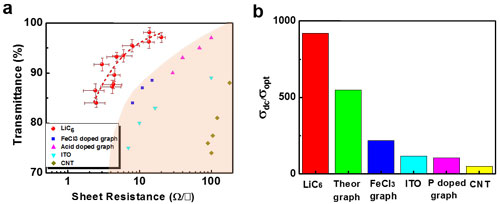| Posted: Jul 24, 2014 | |
Lithium-doped graphene approaches the limits of transparency and conductivity |
|
| (Nanowerk Spotlight) Transparent conductive coatings pervade modern technology. They are a critical component of optoelectronic devices such as smartphone and tablet displays as well as solar cells. The most widely used standard coating is indium tin oxide (ITO), although the use of carbon nanomaterials – carbon nanotubes and graphene – is on the rise. | |
| The search for novel transparent electrode materials with good stability, high transparency and excellent conductivity is driven by the required trade-off between transparency and conductivity: Metals are very conductive but not transparent; plastics are quite transparent but not conductive. However, many optoelectronic applications ideally require electrodes with both, high transparency and high conductivity. | |
| In new work, researchers now have simultaneously increased the conductivity and transparency of ultra thin graphite – ranging from 3-60 graphene layers in thickness – by lithium intercalation, and have achieved the highest combined performance of sheet resistance and transmittance so far reported among all continuous thin-films. | |
| The researchers designed a methodology via a planar nanobattery that allowed them to conduct in situ studies of the electrical and optical properties of few-layer graphene sheets during electrochemical intercalation and deintercalation of lithium. | |
| "We doped few-layer graphene by inserting lithium in between the graphene layers," Jiayu Wan, a PhD student in Liangbing Hu's research group at the University of Maryland, tells Nanowerk. "As a result of this electrochemical intercalation, the Fermi level is upshifted by the doping effect, resulting in a more transparent and conductive material." | |
| Wan, together with Wenzhong Bao, is first author of a paper published in the July 1, 2014 online edition of Nature Communications ("Approaching the limits of transparency and conductivity in graphitic materials through lithium intercalation"). Hu's team collaborated with the research group of Michael Fuhrer at Monash University. | |
| In previous studies, researchers already tried to achieve a combined increase of both transmittance and conductivity. Some of the best results have been achieved by acid doping and FeCl3 intercalation (see for instance: "Novel Highly Conductive and Transparent Graphene-Based Conductors"). | |
| "However, these previous doping/intercalation efforts just increased the conductivity compared to pristine few-layer graphene; the transmittance in the visible range at best stayed unchanged or even decreased," notes Wan. | |
| Hu points out that, due to the unusual band structure of graphene, lithium intercalation can simultaneously increase the DC electrical conductivity and increase optical transmission in the visible, allowing Li-intercalated few-layer graphene to achieve an unprecedented Figure of Merit σdc/σopt = 920, significantly higher than any other material and approaching the ultimate limit expected for doped graphene systems. | |
 |
|
| Optoelectronic properties of intercalated ultrathin graphite sheets and comparison with other materials. (a) Transmittance at 550nm versus sheet resistance for the team's LiC6 few-layer graphene, and other high-performance carbon-based transparent conducting materials FeCl3-doped graphene, acid-doped graphene and carbon nanotube (CNT) films, as well as ITO. (b) FOM (σdc/σopt) for various materials. A higher value for σdc/σopt leads to a better performance in transparent conductor. (Reprinted with permission by Nature Publishing Group) (click on image to enlarge) | |
| As the lithium intercalated graphene material is not very stable in air, the team improved the stability of the intercalation compound with an air-tight sealing. | |
| "In addition to elucidating the limits of conductivity and transparency in ultrathin graphite, we expect that the experimental techniques developed here will be broadly useful for studying the intercalation dynamics and correlated optoelectronic properties of other 2D nanomaterials that can be intercalated electrochemically," concludes Hu. | |
 By
Michael
Berger
– Michael is author of three books by the Royal Society of Chemistry:
Nano-Society: Pushing the Boundaries of Technology,
Nanotechnology: The Future is Tiny, and
Nanoengineering: The Skills and Tools Making Technology Invisible
Copyright ©
Nanowerk LLC
By
Michael
Berger
– Michael is author of three books by the Royal Society of Chemistry:
Nano-Society: Pushing the Boundaries of Technology,
Nanotechnology: The Future is Tiny, and
Nanoengineering: The Skills and Tools Making Technology Invisible
Copyright ©
Nanowerk LLC
|
|
|
Become a Spotlight guest author! Join our large and growing group of guest contributors. Have you just published a scientific paper or have other exciting developments to share with the nanotechnology community? Here is how to publish on nanowerk.com. |
|
